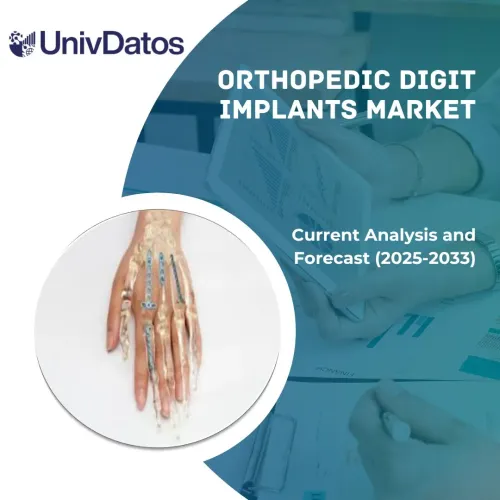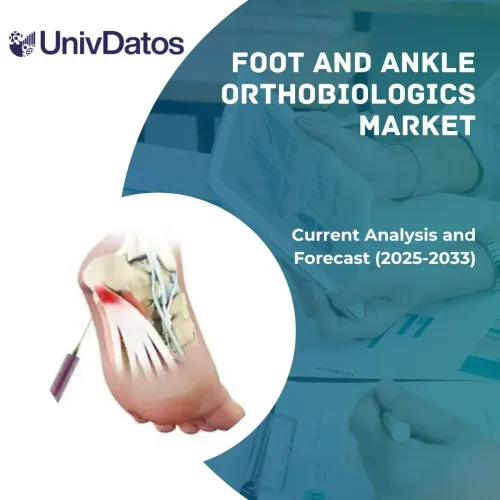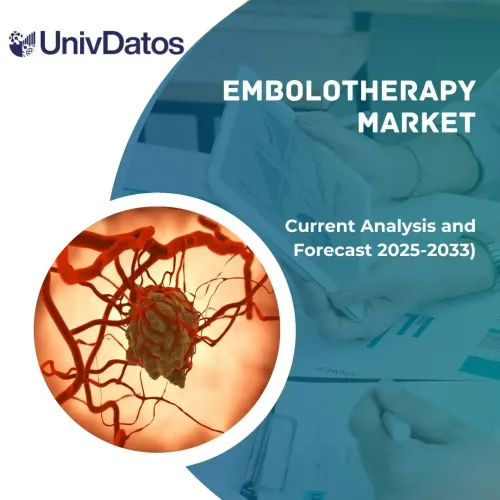- Home
- About Us
- Industry
- Services
- Reading
- Contact Us
Brain Monitoring Market: Current Analysis and Forecast (2021-2027)
Emphasis on Product (Devices, Accessories); Disease (Traumatic Brain Injury (TBI), Stroke, Dementia, Headache Disorders, Sleep Disorders, Parkinson’s Disease, Epilepsy, Huntington’s Disease, Others), Procedure (Invasive, Non-Invasive); End-User (Hospitals, Neurology Centers, Diagnostic Centers, Ambulatory Surgery Centers & Clinics, Others); Region and Country
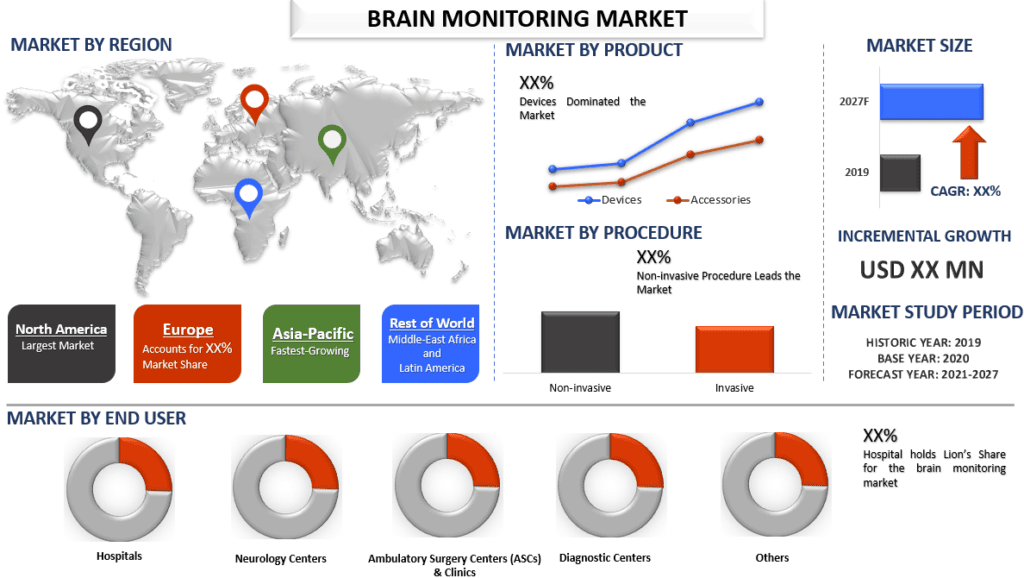
Brain Monitoring Market was valued at US$ 6 billion in 2020 and is expected to grow at a CAGR of 6.5% over the forecast period (2021-2027). Brain monitoring devices are used to monitor and diagnose neurological conditions by exploring the structure and function of the brain. This process involves the use of several brain monitoring devices such as electroencephalography devices, intracranial pressure monitors, and magnetoencephalography to track brain functions. In addition, these devices help monitor neural and electrical activity in the brain. At present, there is an increase in the demand for electroencephalography devices among healthcare providers.
The presence of high incidence rates of diseases leading to brain disorders such as epilepsy, Alzheimer’s disease, brain tumors, and multiple sclerosis will also serve this market as high impact rendering drivers. According to the estimates of the WHO in 2011 the global prevalence of epilepsy and multiple sclerosis was calculated at 50 million and 2.5 million respectively. This alarming statistic goes to show the dire need for brain monitoring devices in the global healthcare industry today. The market offers a wide range of devices to treat the abnormal brain activities and restore its functioning, depending on the case.
Rate of Death with Epilepsy As The Underlying Cause in the U.S. from 2015 to 2019 (Per 100,000 Population)

This statistic shows the rate of death in the U.S. with epilepsy as the underlying cause from 2015 to 2019. In 2019, the death rate for epilepsy was 0.5 per 100,000 population, a slight increase from a rate of 0.4 in the year 2015.
Epilepsy is a general term used to describe a group of related neurological disorders characterized by recurrent seizures. Seizures among epileptics can vary in frequency and seriousness and can last a few seconds or a few minutes. Some of the most common seizure triggers among epileptics include bright flashing lights, stress, lack of sleep, illness or fever, and alcohol, caffeine, and other drugs. In most cases, the cause of epilepsy is unknown, but the disorder can result from stroke, brain injury, brain tumors, and serious illness or very high fever. Approximately 1.1 percent of the population of the U.S. currently lives with epilepsy, with the disorder occurring equally among men and women.
Natus Medical, Inc., Nihon Kohden Corporation, Philips Healthcare, GE Healthcare, Siemens Healthineers, Compumedics, Ltd., Medtronic, CAS Medical Systems, Drägerwerk AG & Co. KGaA and Masimo Corporation are some of the prominent players operating in the global brain monitoring market. Several M&A’s along with partnerships have been undertaken by these players to develop new and advanced products.
Insights Presented in the Report
“Amongst product, devices segment holds the major share”
Based on product, the Brain Monitoring market is segmented into devices and accessories. The devices segment held the largest share of the brain monitoring market in 2019. This is mainly due to the rising incidence of neurological, neurodegenerative, psychotic, and sleep disorders, the need for early diagnosis, the availability of innovative portable and wearable home-based monitoring devices, and increasing patient awareness.
“Amongst disease, the traumatic brain injury (TBI) segment holds the major share”
Based on disease, the brain monitoring market is segmented into traumatic brain injury (TBI), stroke, dementia, headache disorders, sleep disorders, Parkinson’s disease, epilepsy, Huntington’s disease, and other diseases. Traumatic brain injury (TBI) holds the largest share of the brain monitoring market by a medical condition. A major factor responsible for the large share of this market segment is the growing incidence of TBIs across the globe, leading to high demand for the management of these cases, thus requiring the intensive use of brain monitoring devices.
Amongst procedure, the non-invasive segment is projected to show fastest growth”
Depending on procedure, the market is categorized into invasive and non-invasive. The non-invasive segment is projected to show fastest growth during the forecast period, due to rise in incidences of traumatic brain injuries, high acceptance rate of minimally invasive devices, and low risk of mortality. This increases the demand for these products that propels the market growth.
“Amongst end-user, the hospitals segment holds the major share”
Based on end-users, the global brain monitoring devices market is segmented into hospitals, neurology centers, diagnostic centers, ASCs & clinics, and other end users. The hospital segment held the largest share of the global brain monitoring market in 2019. Brain monitoring is a complex process, requiring expensive and advanced devices and equipment that are mainly found in hospitals. Hospitals also see a considerably larger inflow of patients as compared to small clinics and other end users. Additionally, brain monitoring devices pose a considerable burden in terms of maintenance expenses on healthcare facilities; hospitals, more than other end-users, can bear such costs. Hence, brain monitoring devices are mostly used in hospitals, which consequently account for the largest share of this market segment.
“North America signifies one of the largest markets of Brain Monitoring market”
For a better understanding of the market dynamics of the Brain Monitoring market, a detailed analysis was conducted for different regions across the globe including North America (United States, Canada, and the Rest of North America), Europe (Germany, France, Italy, Spain, United Kingdom and Rest of Europe), Asia-Pacific (China, Japan, India, South Korea, and Rest of APAC), Rest of World has been conducted. North America is expected to dominate the Brain Monitoring market due to growing incidence of neurological diseases, a growing number of clinical trials of brain monitoring products, and the availability of medical reimbursement in the US. However, Asia-Pacific is expected to experience the highest growth rate during the forecast period, due to increase in number of geriatric population and rise in purchasing power of countries in the region.
Reasons to buy this report:
- The study includes market sizing and forecasting analysis validated by authenticated key industry experts
- The report presents a quick review of overall industry performance at one glance
- The report covers an in-depth analysis of prominent industry peers with a primary focus on key business financials, product portfolio, expansion strategies, and recent developments
- Detailed examination of drivers, restraints, key trends, and opportunities prevailing in the industry
- The study comprehensively covers the market across different segments
- Deep dive regional level analysis of the industry
Customization Options:
The Brain Monitoring market can further be customized as per the requirement or any other market segment. Besides this, UMI understands that you may have your own business needs, hence feel free to connect with us to get a report that completely suits your requirements.
Table of Content
Analyzing the historical market, estimation of the current market, and forecasting the future market of the Global Brain Monitoring Market were the three major steps undertaken to create and analyze the adoption of brain monitoring for the different diseases across major regions globally. Exhaustive secondary research was conducted to collect the historical market numbers and estimate the current market size. Secondly, to validate these insights, numerous findings and assumptions were taken into consideration. Moreover, exhaustive primary interviews were also conducted, with industry experts across the value chain of brain monitoring. Post assumption and validation of market numbers through primary interviews, we employed a top-down approach to forecast the complete market size. Thereafter, market breakdown and data triangulation methods were adopted to estimate and analyze the market size of segments and sub-segments the industry pertains to. Detailed methodology is explained below:
Analysis of Historical Market Size
Step 1: In-Depth Study of Secondary Sources:
Detailed secondary study was conducted to obtain the historical market size of the brain monitoring market through company internal sources such as annual report & financial statements, performance presentations, press releases, etc., and external sources including journals, news & articles, government publications, competitor publications, sector reports, third-party database, and other credible publications.
Step 2: Market Segmentation:
After obtaining the historical market size of the brain monitoring market, we conducted a detailed secondary analysis to gather historical market insights and share for different segments for major regions. Major segments included in the report are technology, procedure, medical condition, and end-user. Further country-level analyses were conducted to evaluate the overall utilization of brain monitoring in every region.
Step 3: Factor Analysis:
After acquiring the historical market size of different segments and sub-segments, we conducted a detailed factor analysis to estimate the current market size of brain monitoring market. Further, we conducted factor analysis using dependent and independent variables such as increasing incidence of sport injuries. A thorough analysis was conducted for demand and supply-side scenario considering top partnerships, merger and acquisition, business expansion, and product launches in the brain monitoring industry across the globe.
Current Market Size Estimate & Forecast
Current Market Sizing: Based on actionable insights from the above 3 steps, we arrived at the current market size, key players in the brain monitoring market, and market shares of the segments. All the required percentage shares split, and market breakdowns were determined using the above-mentioned secondary approach and were verified through primary interviews.
Estimation & Forecasting: For market estimation and forecast, weights were assigned to different factors including drivers & trends, restraints, and opportunities available for the stakeholders. After analyzing these factors, relevant forecasting techniques i.e. top-down/bottom-up approach was applied to arrive at the market forecast about 2027 for different segments and subsegments across the major markets globally. The research methodology adopted to estimate the market size encompasses:
- The industry’s market size, in terms of value (USD) and the utilization rate of Brain Monitoring across the major markets domestically
- All percentage shares, splits, and breakdowns of market segments and sub-segments
- Key players in the brain monitoring market in terms of services offered. Also, the growth strategies adopted by these players to compete in the fast-growing market
Market Size and Share Validation
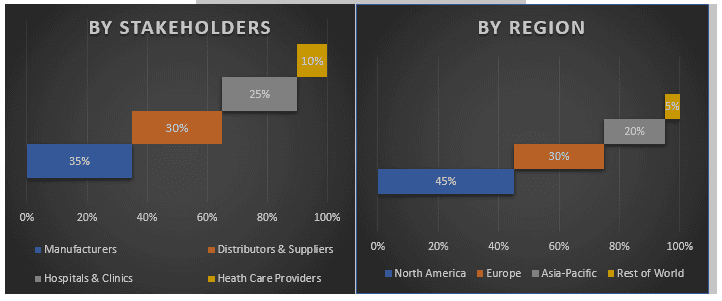
Primary Research: In-depth interviews were conducted with the Key Opinion Leaders (KOLs) including Top Level Executives (CXO/VPs, Sales Head, Marketing Head, Operational Head, and Regional Head, Country Head, etc.) across major regions. Primary research findings were then summarized, and statistical analysis was performed to prove the stated hypothesis. Inputs from primary research were consolidated with secondary findings, hence turning information into actionable insights.
Split of Primary Participants in Different Regions
Market Engineering
Data triangulation technique was employed to complete the overall market estimation and to arrive at precise statistical numbers of each segment and sub-segment of the Brain Monitoring market. Data was split into several segments & sub-segments post studying various parameters and trends in the areas of product, application, end user of the Brain Monitoring market.
Main Objective of the Brain Monitoring Market Study
The current & future market trends of Brain Monitoring were pinpointed in the study. Investors can gain strategic insights to base their discretion for investments from the qualitative and quantitative analysis performed in the study. Current and future market trends were determined the overall attractiveness of the market at a regional level, providing a platform for the industrial participant to exploit the untapped market to benefit as a first-mover advantage. Other quantitative goals of the studies include:
- Analyze the current and forecast market size of brain monitoring in terms of value (USD). Also, analyze the current and forecast market size of different segments and sub-segments
- Segments in the study include areas of technology, procedure, medical condition, and end-user
- Define and analysis of the regulatory framework for the brain monitoring industry
- Analyze the value chain involved with the presence of various intermediaries, along with analyzing customer and competitor behaviors of the industry
- Analyze the current and forecast market size of the brain monitoring market for the major region
- Major regions studied in the report include North America (United States, Canada, and the Rest of North America), Europe (Germany, France, Italy, Spain, United Kingdom and Rest of Europe), Asia-Pacific (China, Japan, India, South Korea, and Rest of APAC), and Rest of the World
- Company profiles of the Brain Monitoring market and the growth strategies adopted by the market players to sustain in the fast-growing market
Deep dive regional level analysis of the industry
Related Reports
Customers who bought this item also bought





